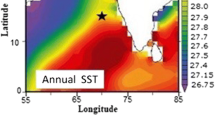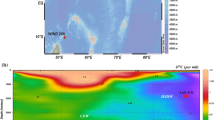Abstract
High-resolution oxygen-isotope records of benthic ostracods and molluscs from Ammersee, southern Germany, show high-frequency climatic changes during the last deglaciation and parallel in great detail published faunal and floral variations reconstructed from Norwegian Sea sediments and isotope variations in Greenland ice cores. The marine and the terrestrial records give evidence of a synchronous late glacial climatic development in Greenland, NW- and Mid-Europe. However,14C-ages of the supraregional climatic events and of two tephra layers in the marine sediments of the northeastern Atlantic Ocean are significantly older than the14C-ages of the corresponding horizons on land. These differences strongly suggest that major short-term events have affected the exchangeable carbon on earth during the dramatic environmental changes related to the deglaciation and in particular have affected the CO2-distribution within the ocean and between ocean and atmosphere. Dating methods independent of climatic variations and of the global carbon budget should be given priority to refine the timescales of the marine and atmospheric processes during the last deglaciation.
Similar content being viewed by others
References
Absolon, A., 1973. Ostracoden aus einigen Profilen spät- und post-glazialer Karbonatablagerungen in Mitteleuropa. Mitt. Bayer. Staatssamml. Paläont. hist. Geol. 13: 47–94.
Becker, B., B. Kromer & P. Trimborn, 1991. A stable-isotope tree-ring timescale of the Late-Glacial/Holocene boundary. Nature 353: 647–649.
Berger, W. H., 1990. The Younger Dryas cold spell — a quest for causes. Palaeogeogr. Palaeoclimatol. Palaeoecol. 89: 219–237.
Bogaard, P. & H.-U. Schmincke, 1985. A widespread isochronous late quaternary tephra layer in central and northern Europe. Geol. Soc. Amer. Bull. 96: 1554–1571.
Broecker, W. S., M. Andree, W. Wölfli, H. Oeschger, G. Bonani, J. Kennett & D. Peteet, 1988. The chronology of the last deglaciation: implications to the cause of the Younger Dryas event. Paleoceanography 3: 1–19.
Broecker, W. S., J. P. Kennett, B. P. Flower, J. T. Teller, S. Trumbore, G. Bonani & W. Wölfli, 1989. Routing of meltwater from the Laurentide ice sheet during the Younger Dryas cold episode. Nature 341: 318–321.
Dansgaard, W., J. W. C. White & S. J. Johnsen, 1989. The abrupt termination of the Younger Dryas climate event. Nature 339: 532–534.
Eicher, U., 1987. Die spätglazialen sowie die frühholozänen Klimaverhältnisse im Bereich der Alpen: Sauerstoffisotopenkurven kalkhaltiger Sedimente. Geogr. Helvet. 42: 99–104.
Engstrom, D. R., B. C. S. Hansen & H. R. Wright jr., 1991. A possible Younger Dryas record in southeastern Alaska. Science 250: 1383–1385.
Fairbanks, R. G., 1989. A 17000-year glacio-eustatic sea level record: influence of glacial melting rates on the Younger Dryas event and deep-ocean circulation. Nature 342: 637–642.
Heusser, C. J & J. Rabassa, 1987. Cold climatic episode of Younger Dryas age in Tierra del fuego. Nature 328: 609–612.
Jansen, E & T. Veum, 1990. Evidence on two-step deglaciation and its impact on North Altlantic deep water circulation. Nature 343: 612–616.
Johnsen, S. J., H. B. Clausen, W. Dansgaard, K. Fuhrer, N. Gundestrup, C. H. Hammer, P. Iversen, J. Jouzel, B. Stauffer & J. P. Steffensen, 1992. Irregular glacial interstadials recorded in a new Greenland ice core. Nature 359: 311.
Kallel, N., L. D. Labeyrie, M. Arnold, H. Okada, W. C. Dudley & J.-C. Duplessey, 1988. Evidence of cooling during the Younger Dryas in the western Pacific. Oceanol. Acta 11: 369–375.
Karpuz, N. K. & E. Jansen, 1992. A high-resolution diatom record of the last deglaciation from the SE Norwegian Sea: documentation of rapid climatic changes. Palaeoceanography 7: 449–520.
Keir, R. S., 1983. Reduction of the thermohaline circulation during deglaciation: the effect on atmospheric radiocarbon and CO2. Earth Planet. Sci. Letters 64: 445–456.
Klee, R., R. Schmidt & J. Müller, 1993. Alleröd diatom assemblages in prealpine hardwater lakes of Bavaria and Austria as preserved by the Laacher See eruption event. Limnologica 23: 131–143.
Kleinmann, A., 1992. Nachweis spät- und postglazialer Seespiegelschwankungen am Ammersee mittels pollenanalytischer und sedimentologischer Untersuchungen. Diss., Techn. Univ. München.
Klie, W., 1938. Ostracoda, Muschelkrebse. Die Tierwelt Deutschlands und der umgebenden Meeresgebiete, 34: 172–230.
Kudrass, H. R., H. Erlenkeuser, R. Vollbrecht & W. Weiß, 1991. Global nature of the Younger Dryas cooling event inferred from oxygen isotope data from Sulu Sea cores. Nature 349: 406–409.
Lehmann, S. J. & L. D. Keigwin, 1992, Sudden changes in North Atlantic circulation during the last deglaciation. Nature 356: 757–762.
Lotter, A. F., 1991. Absolute dating of the late-glacial period in Switzerland using annually laminated sediments. Quat. Res. 35: 321–330.
Lotter, A. F., U. Eicher, U. Siegenthaler & H. J. B. Birks. Late-glacial climatic oscillations as recorded in Swiss lake sediments. J. Quat. Sci. 7: 187–204.
Mangerud, J., S. E. Lie, H. Furnes, I. L. Kristiansen & L. Lömo, 1984. A Younger Dryas ash bed in western Norway and its possible correlations with tephra in cores from the Norwegian Sea and the North Atlantic. Quat. Res. 21: 85–104.
Mangerud, J., H. Furnes & J. Jóhansen, 1986. A 9000-year-old ash bed on the Faroe Islands. Quat. Res. 26: 262–265.
Von Grafenstein, U., H. Erlenkeuser, J. Müller & A. Kleinmann-Eisenmann, 1992. Oxygen isotope records of benthic ostracods in bavarian lake sediments: reconstruction of late and post glacial air temperatures. Naturwissenschaften 79: 145–152.
Author information
Authors and Affiliations
Additional information
This is the fourth paper in a series of papers published in this issue on high-resolution paleolimnology. These papers were presented at the Sixth International Palaeolimnology Symposium held 19–21 April, 1993 at the Australian National University, Canberra, Australia. Dr. A. F. Lotter and Dr. M. Sturm served as guest editors for these papers.
Rights and permissions
About this article
Cite this article
von Grafenstein, U., Erlenkeuser, H., Kleinmann, A. et al. High-frequency climatic oscillations during the last deglaciation as revealed by oxygen-isotope records of benthic organisms (Ammersee, southern Germany). J Paleolimnol 11, 349–357 (1994). https://doi.org/10.1007/BF00677994
Received:
Accepted:
Issue Date:
DOI: https://doi.org/10.1007/BF00677994




